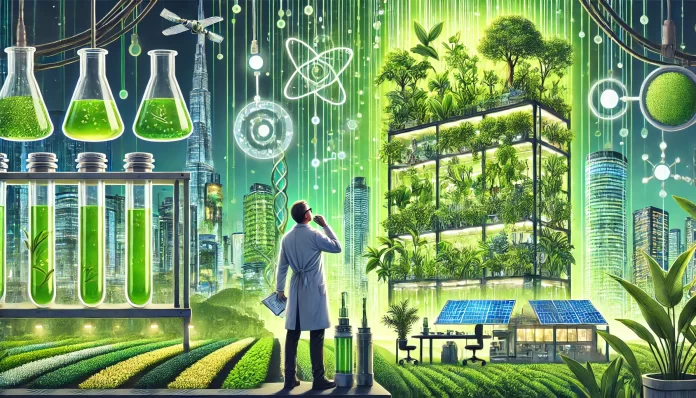Chapter 5: Plants in the Modern World
As the 21st century unfolds, plants continue to play a central role in the survival and evolution of life on Earth. They are more than just providers of food and oxygen—they are allies in the fight against climate change, innovators in science and technology, and symbols of beauty and resilience in human culture. This chapter explores the modern relationship between plants and the challenges and opportunities that lie ahead.
Plants and Climate Change
With rising global temperatures and increasing carbon dioxide levels, plants are both victims and heroes of climate change. Deforestation, habitat loss, and pollution threaten countless plant species, but plants also offer powerful solutions to mitigate the crisis.
- Carbon Sequestration: Forests, wetlands, and grasslands act as carbon sinks, absorbing atmospheric CO₂ and slowing global warming. Reforestation projects and the protection of natural habitats are critical tools in this effort.
- Urban Greening: Trees and green roofs in urban areas reduce heat, improve air quality, and lower energy use, making cities more sustainable.
- Climate-Resilient Crops: Scientists are developing drought-tolerant, heat-resistant, and flood-resistant crops to ensure food security in a warming world.
Plants in Technology and Science
The modern era has brought a wave of innovation in plant-based science and technology, revealing new ways plants can benefit humanity.
- Biofuels: Plants like corn, sugarcane, and algae are being used to create renewable energy sources that could reduce dependence on fossil fuels.
- Medicines: Many modern drugs are derived from plants, such as cancer-fighting compounds from the Madagascar periwinkle (Catharanthus roseus) and painkillers like morphine from the opium poppy.
- Synthetic Biology: Scientists are engineering plants to produce vaccines, bioplastics, and even light, as seen in experiments with glowing plants.
- Space Exploration: Plants are central to plans for long-term space missions, providing oxygen, food, and psychological comfort for astronauts in environments like the Moon or Mars.
Plants and Culture in the Anthropocene
As the world becomes increasingly urbanized and digital, plants remain vital to human well-being and cultural identity.
- Horticultural Therapy: Gardening and exposure to green spaces are proven to reduce stress, improve mental health, and enhance physical well-being.
- Houseplant Renaissance: The recent surge in houseplant popularity reflects a desire to reconnect with nature, even in indoor environments.
- Art and Design: Plants inspire architecture, fashion, and art, from botanical motifs in clothing to biophilic designs in buildings.
The Threats Plants Face
Despite their importance, plants are under unprecedented threat.
- Biodiversity Loss: It is estimated that one in five plant species is at risk of extinction due to deforestation, invasive species, and climate change.
- Agricultural Pressures: Monoculture farming and overuse of pesticides harm ecosystems and reduce genetic diversity in crops.
- Pollinator Declines: The loss of bees, butterflies, and other pollinators jeopardizes the reproduction of flowering plants, including many food crops.
The Future of Plants and People
As we move further into the Anthropocene—the age of human influence on the planet—our relationship with plants is entering a critical phase. Scientists, activists, and governments are working to:
- Protect natural ecosystems through conservation efforts and sustainable land management.
- Develop alternative materials, such as plant-based plastics and textiles, to reduce environmental impact.
- Promote education and awareness about the importance of plants in our lives.
A Call to Action
The future of plants is inextricably linked to the future of humanity. By protecting and nurturing the green world, we ensure our own survival. Whether it’s planting a tree, supporting sustainable agriculture, or reducing waste, every action matters.
Plants are more than resources—they are living, breathing allies that shape the world around us. From the ancient cyanobacteria that first filled the air with oxygen to the crops that sustain billions today, their story is one of resilience and evolution. And as stewards of this planet, it’s up to us to ensure their story continues to bloom.
Read the final chapter about the possibilities of advanced scientific uses




